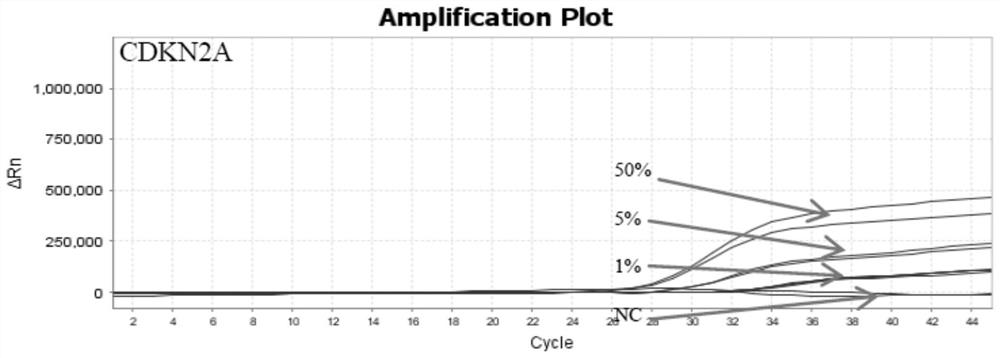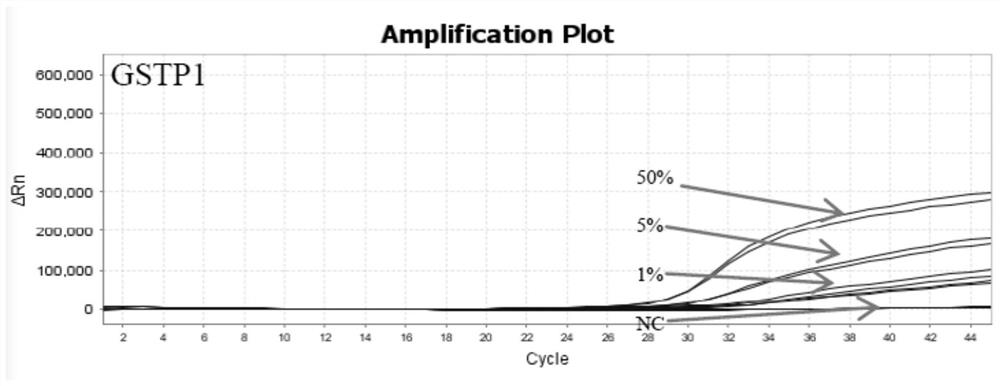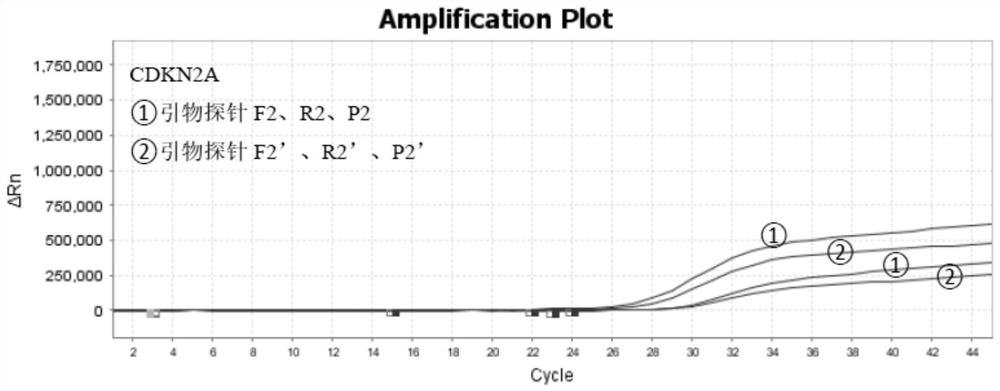Primer probe composition, kit and method for early screening of liver cancer
A primer-probe and composition technology, which can be used in biochemical equipment and methods, recombinant DNA technology, and microbial assay/inspection, etc., can solve problems such as prevention and early screening of unwell liver cancer, achieve high sensitivity and specificity, improve Good accuracy and sensitivity
- Summary
- Abstract
- Description
- Claims
- Application Information
AI Technical Summary
Problems solved by technology
Method used
Image
Examples
Embodiment 1
[0043] Embodiment 1: Kit
[0044] The kit is an early screening and prognosis monitoring kit for liver cancer, and a kit for simultaneously detecting the methylation of two genes in blood cells. The two genes and the internal reference ACTB gene are combined to form a triple nucleic acid reaction solution. The kit includes nucleic acid reaction solution A and nucleic acid reaction solution B, wherein nucleic acid reaction solution A includes a primer-probe composition, and nucleic acid reaction solution B is purchased qPCR PreMix (Probe). See Table 1 for specific information on the primers and probes of the nucleic acid reaction solution A.
[0045] Table 1 The sequence of the primer probe composition
[0046]
[0047] Among them, the 5' end of probe P1 is labeled with a FAM fluorescent reporter group, and the 3' end is labeled with a BHQ-1 fluorescent quencher group; the 5' end of probe P2 is labeled with a VIC fluorescent reporter group, and the 3' end is labeled with T...
Embodiment 2
[0062] Embodiment 2: Sensitivity experiment
[0063] The sensitivity of the kit of Example 1 was tested. Among them, three gradients of 50%, 5% and 1% were set for the methylation rate of CDKN2A gene and GSTP1 gene. For test results, see figure 1 and image 3 As shown, the results show that the kit has good sensitivity and can detect 1% of the liver cancer gene methylation rate in the sample.
Embodiment 3
[0064] Embodiment 3: specificity experiment
[0065] The kit of Example 1 was used to detect 23 clinical samples, including 5 samples of fatty liver, 7 samples of hepatitis and 11 samples of liver cancer. The kit was used to detect each sample separately, and the sample volume of each sample DNA was 14 μL. The reaction procedure is as in Table 3 above.
[0066] The information of 27 clinical samples is shown in Table 4.
[0067] Table 4 Clinical sample information
[0068]
[0069]
[0070] Calculate the sensitivity and specificity of the kit according to Table 4 as follows:
[0071] Sensitivity: number of detected liver cancer / total number of liver cancer×100%=(9 / 11)×100%=81.82%.
[0072] Specificity: Number of detected non-bladder cancer / total number of non-bladder cancer×100%=(12 / 12)×100%=100%.
[0073] The kit and detection method have good sensitivity and specificity.
PUM
| Property | Measurement | Unit |
|---|---|---|
| Sensitivity | aaaaa | aaaaa |
Abstract
Description
Claims
Application Information
 Login to View More
Login to View More - R&D Engineer
- R&D Manager
- IP Professional
- Industry Leading Data Capabilities
- Powerful AI technology
- Patent DNA Extraction
Browse by: Latest US Patents, China's latest patents, Technical Efficacy Thesaurus, Application Domain, Technology Topic, Popular Technical Reports.
© 2024 PatSnap. All rights reserved.Legal|Privacy policy|Modern Slavery Act Transparency Statement|Sitemap|About US| Contact US: help@patsnap.com










